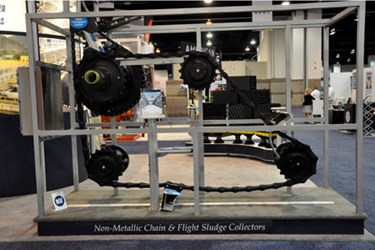Cleaning A Sedimentation Basin

John Stevenson of Brentwood Industries explains the need and process of cleaning a sedimentation basin
The following is an excerpt from a Q&A with Water Online Radio. Click on the Radio Player above to hear the full interview.
Water Online Radio: Why do I need a vacuum cleaner for a sedimentation basin?
John: Well, it's a good question. Perhaps we don't think about having to clean up the sedimentation basins. Let me tell you about a small town in Ohio -- Tiffon, Ohio. It’s part of this big agricultural community, and as with a lot of surface water systems, they get a lot of sediment.
In this agricultural area, you get a lot of runoff from the fields and whatnot. It really exacerbates this problem of sludge. As requirements get stricter and stricter and you add more coagulants, now you've got even more sludge settling out in these sedimentation basins.
There are two ways to clean it. You can do it manually. Take the basins down, stop billing water, lose productivity, put people at risk for safety, especially in the wintertime, when there's water in ice. Or you can remove it with an automatic removal system, some type of vacuum or even a chain in flight, some type of scraper system to push it to a sump and remove the sediment. Either way, you've got to get it out of there, so it prevents short-circuiting and other problems.
Water Online Radio: How does that impact the end user? How does it manifest itself long-term?
John: Well, long-term, you've got to have clean water. We like to think about cleaning America's water. These vacuum systems help to get the sludge out, so that the purified water is at the top and is being drawn out through the effluent troughs or whatnot, and the sludge is at the bottom.
If you have the sludge build up, all of a sudden you've got to take the tank down to clean it out. If you don't do that, you short-circuit. If you short-circuit, you might get a knock on the door from the EPA or whatever authorities come to that.
Water Online Radio: I can't help but think of my buddy's pool in Florida, and they've got creepy crawly things running around the bottom of the pool. Is that the right image I should have? It's got to be more sophisticated than that.
John: It is a little bit more sophisticated, but that's a good image. In fact, Brentwood got started with an electric rover-type thing from Sweden that went back and forth with an underwater electric drive and cleaned up, but what we found is that not every application was perfect for an underwater electric drive.
It needed something more reliable, like a cable drive system, which we've helped to develop over the last couple of years. People in the industry use cable drives very frequently.
It's a very reliable method, because the sediment in America is very thick, very highly concentrated. It's not like you're cleaning glacier water, which you could probably just drink without doing any treatment, which is where this Swedish product came from, and while it has its applications, we find that these cable-driven products that we use are reliable.
The way it's designed is to scrape the floor and clean all the way down to the basement floor. It's got a four inch high intake that engulfs this sludge blanket. The triangle headers help to funnel the sludge to the discharge outlets, so we can consistently and reliably clean the basin floor...
Click on the Radio Player above to hear the full interview.
